
Rapier is a surface-to-air missile developed for the British Army to replace their towed Bofors 40/L70 anti-aircraft guns. The system is unusual as it uses a manual optical guidance system, sending guidance commands to the missile in flight over a radio link. This results in a high level of accuracy, therefore a large warhead is not required.

Anti-aircraft warfare or counter-air defence is the battlespace response to aerial warfare, defined by NATO as "all measures designed to nullify or reduce the effectiveness of hostile air action". It includes surface based, subsurface, and air-based weapon systems, associated sensor systems, command and control arrangements, and passive measures. It may be used to protect naval, ground, and air forces in any location. However, for most countries the main effort has tended to be homeland defence. NATO refers to airborne air defence counter-air and naval air defence as anti-aircraft warfare. Missile defence is an extension of air defence, as are initiatives to adapt air defence to the task of intercepting any projectile in flight.
Rheinmetall Air Defence AG is a division of German armament manufacturer Rheinmetall, created when the company's Oerlikon Contraves unit was renamed on 1 January 2009 and integrated with Rheinmetall's other air-defence products. Oerlikon Contraves was a Swiss anti-aircraft artillery manufacturer famous for its adaptation of the 1916 20 mm Becker as the Oerlikon 20 mm autocannon design, which was used in the Second World War and still in use today. Copies and derivatives of these designs were made by German, French, British and Japanese weapon manufacturers. Oerlikon Contraves was purchased by Rheinmetall, a German armament manufacturer, in 1999.
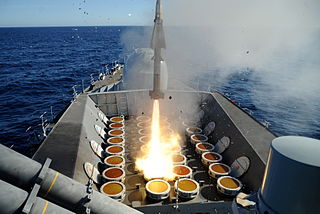
Sea Wolf is a naval surface-to-air missile system designed and built by BAC, later to become British Aerospace (BAe) Dynamics. It is an automated point-defence weapon system designed as a short-range defence against both sea-skimming and high angle anti-ship missiles and aircraft. The Royal Navy has fielded two versions, the GWS-25 Conventionally Launched Sea Wolf (CLSW) and the GWS-26 Vertically Launched Sea Wolf (VLSW) forms. In Royal Navy service Sea Wolf is being replaced by Sea Ceptor.

The Bristol Bloodhound is a British ramjet powered surface-to-air missile developed during the 1950s. It served as the UK's main air defence weapon into the 1990s and was in large-scale service with the Royal Air Force (RAF) and the forces of four other countries.
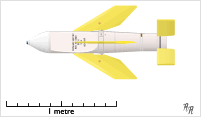
Seacat was a British short-range surface-to-air missile system intended to replace the ubiquitous Bofors 40 mm gun aboard warships of all sizes. It was the world's first operational shipboard point-defence missile system, and was designed so that the Bofors guns could be replaced with minimum modification to the recipient vessel and (originally) using existing fire-control systems. A mobile land-based version of the system was known as Tigercat.

The Defence Research and Development Organisation (DRDO) is an agency under the Department of Defence Research and Development in Ministry of Defence of the Government of India, charged with the military's research and development, headquartered in Delhi, India. It was formed in 1958 by the merger of the Technical Development Establishment and the Directorate of Technical Development and Production of the Indian Ordnance Factories with the Defence Science Organisation.

The Swiss Air Force is the air component of the Swiss Armed Forces, established on 31 July 1914 as part of the army and in October 1936 as an independent service.

The Oerlikon/Martin Marietta Air Defense Anti Tank System is a dual-purpose short range surface-to-air and anti-tank missile system based on the M113A2 vehicle. The ADATS missile is a laser-guided supersonic missile with a range of 10 kilometers, with an electro-optical sensor with TV and Forward Looking Infrared (FLIR). The carrying vehicle also has a search radar with an effective range of over 25 kilometers.

The Oerlikon GDF or Oerlikon 35 mm twin cannon is a towed anti-aircraft gun made by Oerlikon Contraves. The system was originally designated as 2 ZLA/353 ML but this was later changed to GDF-001. It was developed in the late 1950s and is used by around 30 countries.
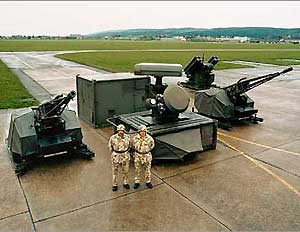
Skyshield is a short range ground-based air defence system developed by the German corporation Rheinmetall based on the work of the subsidiary Swiss company Oerlikon Contraves.
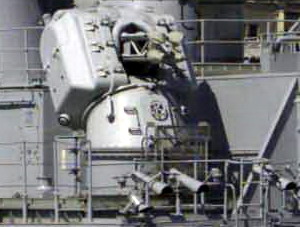
Sea Zenith is a four-barrelled 25 mm CIWS used by the Turkish Navy on their MEKO 200 frigates, like the Barbaros and Yavuz classes. It was developed in the 1980s by Oerlikon Contraves around their Oerlikon KBB gun and manufactured in Switzerland. This automatic gun uses a 25x184mm cartridge at a rate of 800 rounds a minute. Using four independent guns instead of one multi-barrelled rotary cannon improves reliability. The system is mounted in an enclosed automatic turret and directed by the Seaguard radar developed by Contraves. The turret is tilted back to allow a higher elevation to intercept diving missiles. The system's primary purpose is defence against anti-ship missiles, and other precision guided weapons. However it can also be employed against fixed/rotary wing aircraft, ships and other small craft, coastal targets, and floating mines.
List of abbreviations, acronyms and initials related to military subjects such as modern armour, artillery, infantry, and weapons, along with their definitions.
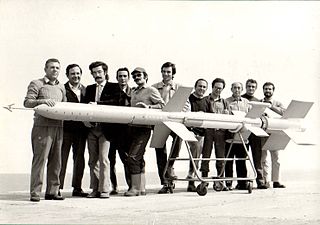
Sea Killer is an Italian anti-ship missile. It has been built in several versions, with differing guidance systems, and is suitable for launching from ships or aircraft; in the latter form the weapons system is known as Marte. A sea-skimming, solid-propellant missile, it carries a 70 kilograms (150 lb) semi-armour piercing warhead. It was initially developed during the 1960s and has been deployed by at least six countries. It was used during the Iran–Iraq War, with at least six ships being hit.

The RSD 58 is an early production surface-to-air missile system developed by Contraves-Oerlikon in Switzerland from 1947. Test firings were made in Switzerland and Italy in 1958, and Japan placed a small order for training purposes, but the missile was not produced in high numbers. The missile system was developed from the earlier RSA Missile developed by the same companies.

The RSA is one of the earliest surface-to-air missiles systems, developed by the Swiss companies Oerlikon-Bührle and Contraves starting in 1947. The missile went through a rapid development process with several upgraded versions, and was the first anti-aircraft missile offered for commercial sale when it was placed on the market in the RSC-50 form. The US tested 25 of the slightly different RSC-51 model under the name MX-1868. No further sales were forthcoming. Several improved versions followed, including the RSC-54, RSC-56, RSC-57 and RSC/RSD-58. These saw small numbers of sales, mostly as training rounds.

The Super Fledermaus, known in Swiss service as the Feuerleitgerät 63, Flt Gt 63, is a pulse-radar fire control system, 111 of these systems were in service with the Swiss Air Force from 1965 to 1977. Under the lead of Contraves, the Super Fledermaus fire control system was jointly developed and produced by ten companies. It replaced the Fire control radar Mark VII in Swiss service, and was in turn replaced by the Skyguard system.
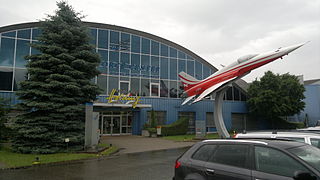
The Flieger Flab Museum is located in the Canton of Zurich in Dübendorf on the grounds of Dübendorf Air Base. In the museum, 40 airplanes and helicopters are displayed, with the collection divided into distinct eras: pioneers and World War I, the 1930s, World War II and the postwar period, the beginning of the jet age, the development of jet fighters, the Cold War, and arms reduction.
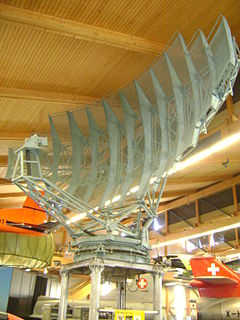
The SFR Airspace monitoring and management system was the first Airspace monitoring and management system of the Swiss Air Force.
The Militärhistorische Stiftung des Kantons Zug MHSZ is a foundation consisting of a group of Military Museums in the canton of Zug with the purpose of safeguarding and cultivating the military heritage of the Swiss Confederation in the canton of Zug.

















